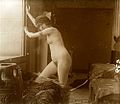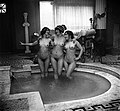
A barometer is a scientific instrument that is used to measure air pressure in a certain environment. Pressure tendency can forecast short term changes in the weather. Many measurements of air pressure are used within surface weather analysis to help find surface troughs, pressure systems and frontal boundaries.
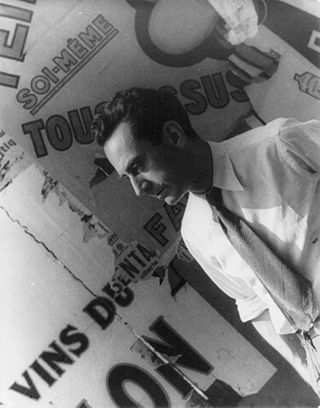
Man Ray was an American visual artist who spent most of his career in Paris. He was a significant contributor to the Dada and Surrealist movements, although his ties to each were informal. He produced major works in a variety of media but considered himself a painter above all. He was best known for his pioneering photography, and was a renowned fashion and portrait photographer. He is also noted for his work with photograms, which he called "rayographs" in reference to himself.

A stereoscope is a device for viewing a stereoscopic pair of separate images, depicting left-eye and right-eye views of the same scene, as a single three-dimensional image.

A barograph is a barometer that records the barometric pressure over time in graphical form. This instrument is also used to make a continuous recording of atmospheric pressure. The pressure-sensitive element, a partially evacuated metal cylinder, is linked to a pen arm in such a way that the vertical displacement of the pen is proportional to the changes in the atmospheric pressure.

Chronophotography is a photographic technique from the Victorian era which captures a number of phases of movements. The best known chronophotography works were mostly intended for the scientific study of locomotion, to discover practical information for animal handlers and/or as reference material for artists. Although many results were not intended to be exhibited as moving pictures, there is much overlap with the more or less simultaneous quest to register and exhibit photographic motion pictures.
Erotic photography is a style of art photography of an erotic, sexually suggestive or sexually provocative nature.
John Benjamin Dancer was a British scientific instrument maker and inventor of microphotography. He also pioneered stereography.
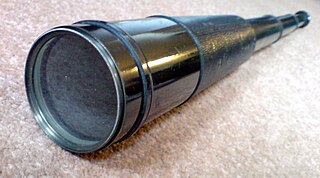
Negretti and Zambra was a company that produced scientific and optical instruments and also operated a photographic studio based in London.
Underwood & Underwood was a producer and distributor of stereoscopic and other photographic images, and later was a pioneer in the field of news bureau photography.
The Keystone View Company was a major distributor of stereographic images, and was located in Meadville, Pennsylvania. From 1892 through 1963 Keystone produced and distributed both educational and comic/sentimental stereoviews, and stereoscopes. By 1905 it was the world's largest stereographic company. In 1963 Department A and the Education Departments were closed down, but Keystone continued to manufacture eye-training stereographic products as a subsidiary of Mast Development Company. In 1972 Mast closed the Meadville manufacturing site.
Thomas Richard Williams was a British professional photographer and one of the pioneers of stereoscopy.
The French firm Susse Frères manufactured a daguerreotype camera which was one of the first two photographic cameras ever sold to the public. The company was also engaged in the foundry business and owned a large foundry in Paris.
Robert Gustave Mouzillat (1913–2010) was the founder of La Stereochromie which traded as RoMo, a stereoscopic image company. In the 1950s Robert Mouzillat, an early pioneer of 3D photography, together with his father, Gustave, invented a 3D camera and created an extensive collection of photographs and film. His contacts in the French government, particularly because of his intelligence work during the War, gave Mouzillat unprecedented access to important people and places in France. The Collection provide an interesting and important view of France in the 1940s, 50s and 60s.

Jean Adolphe Braun was a French photographer, best known for his floral still lifes, Parisian street scenes, and grand Alpine landscapes.
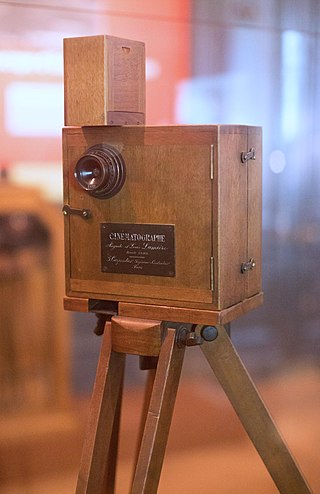
The history of film technology traces the development of techniques for the recording, construction and presentation of motion pictures. When the film medium came about in the 19th century, there already was a centuries old tradition of screening moving images through shadow play and the magic lantern that were very popular with audiences in many parts of the world. Especially the magic lantern influenced much of the projection technology, exhibition practices and cultural implementation of film. Between 1825 and 1840, the relevant technologies of stroboscopic animation, photography and stereoscopy were introduced. For much of the rest of the century, many engineers and inventors tried to combine all these new technologies and the much older technique of projection to create a complete illusion or a complete documentation of reality. Colour photography was usually included in these ambitions and the introduction of the phonograph in 1877 seemed to promise the addition of synchronized sound recordings. Between 1887 and 1894, the first successful short cinematographic presentations were established. The biggest popular breakthrough of the technology came in 1895 with the first projected movies that lasted longer than 10 seconds. During the first years after this breakthrough, most motion pictures lasted about 50 seconds, lacked synchronized sound and natural colour, and were mainly exhibited as novelty attractions. In the first decades of the 20th century, movies grew much longer and the medium quickly developed into one of the most important tools of communication and entertainment. The breakthrough of synchronized sound occurred at the end of the 1920s and that of full color motion picture film in the 1930s. By the start of the 21st century, physical film stock was being replaced with digital film technologies at both ends of the production chain by digital image sensors and projectors.
Comitti of London is a British company which designs and manufactures handcrafted timepieces.

After the Bath, Woman Drying Herself is a pastel drawing by Edgar Degas, made between 1890 and 1895. Since 1959, it has been in the collection of the National Gallery, London. This work is one in a series of pastels and oils that Degas created depicting female nudes. Originally, Degas exhibited his works at Impressionist exhibitions in Paris, where he gained a loyal following.

Joseph L. Bates was an American merchant and manufacturer based in Boston specializing in musical instruments, umbrellas, stereoscopic photographs and viewers, and fancy goods. Despite being a dealer of stereographic photographs, he was likely not a photographer himself.
Pierre François Antoine Molteni, also known as Antoine Molteno or François Molteno, was a manufacturer and trader in optical instruments and other scientific equipment, who built the first devices used by Louis Daguerre and founded the "Maison Molteni" in Paris.

